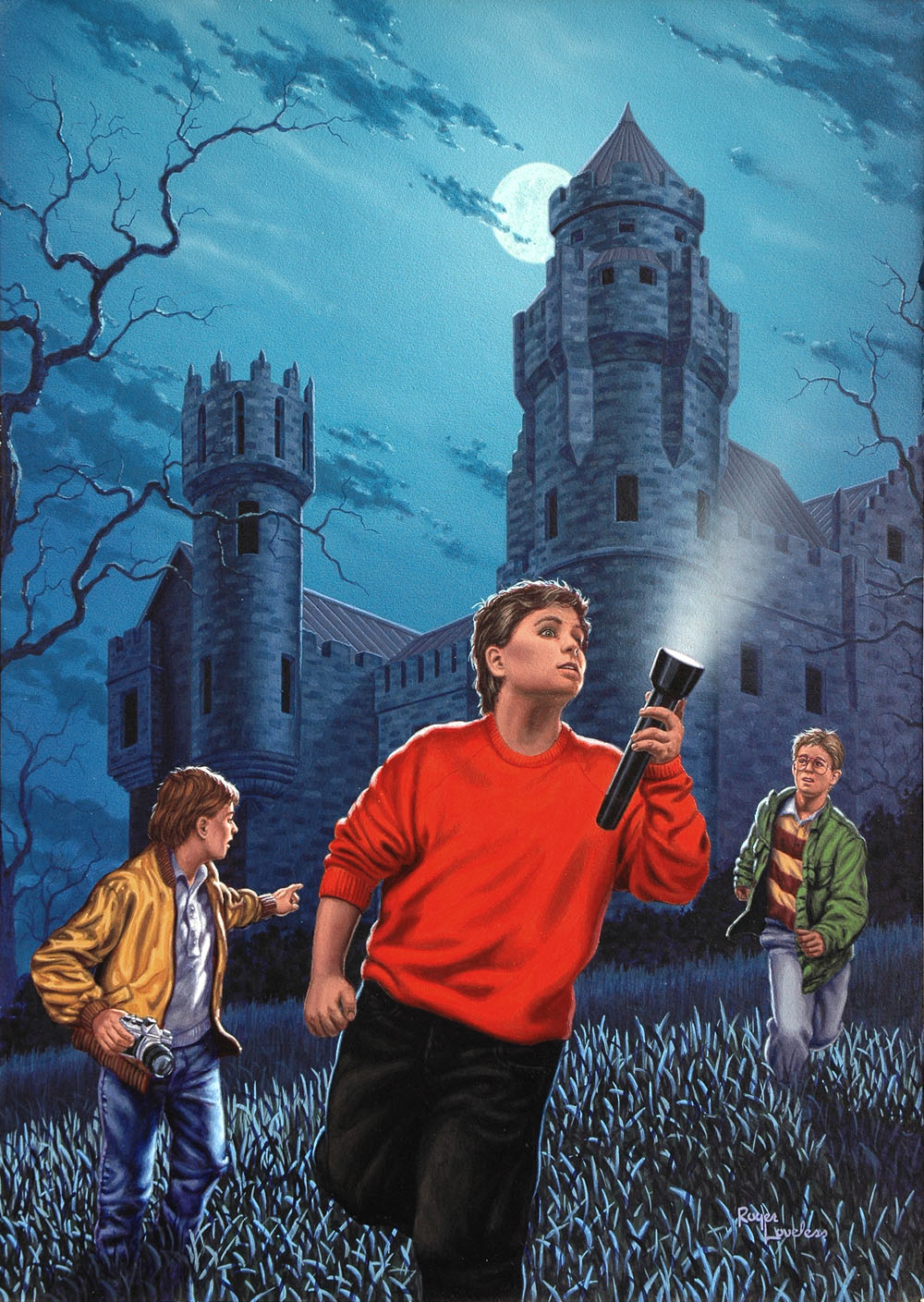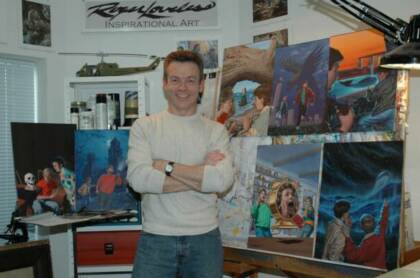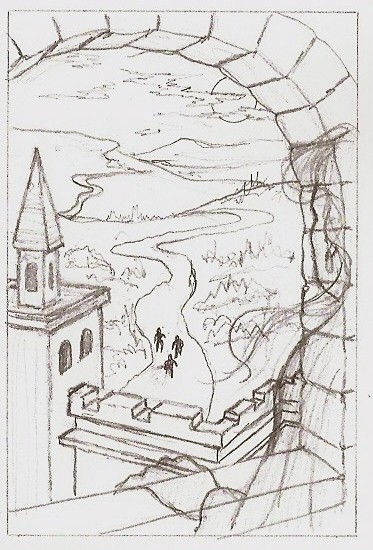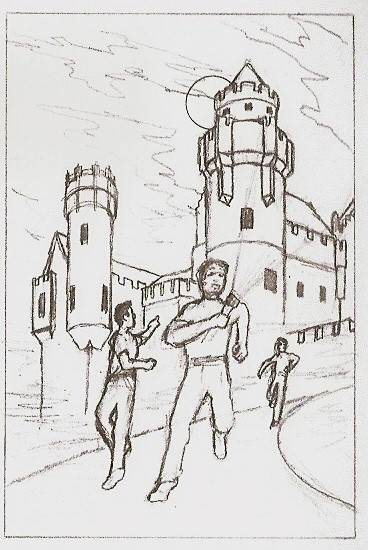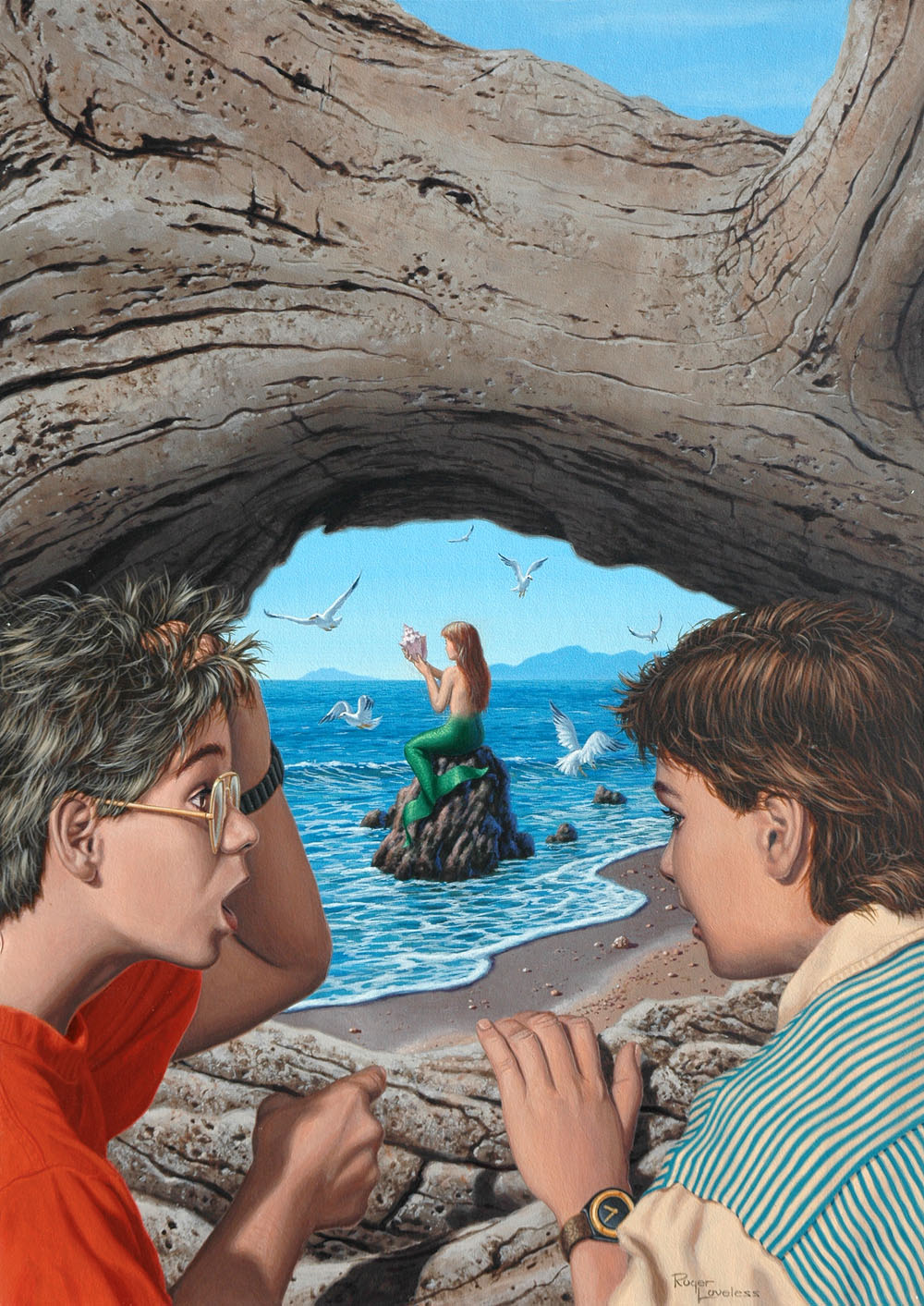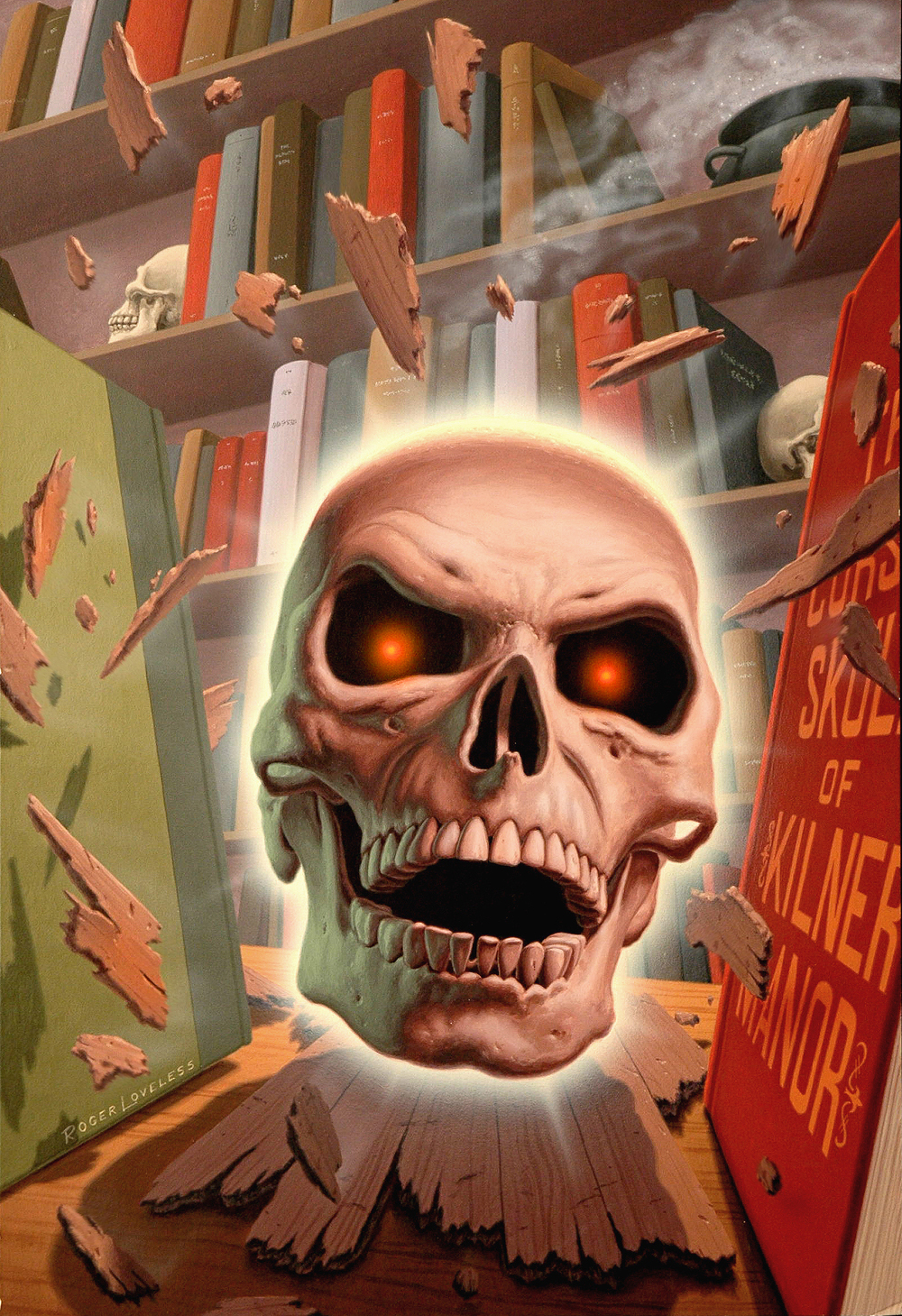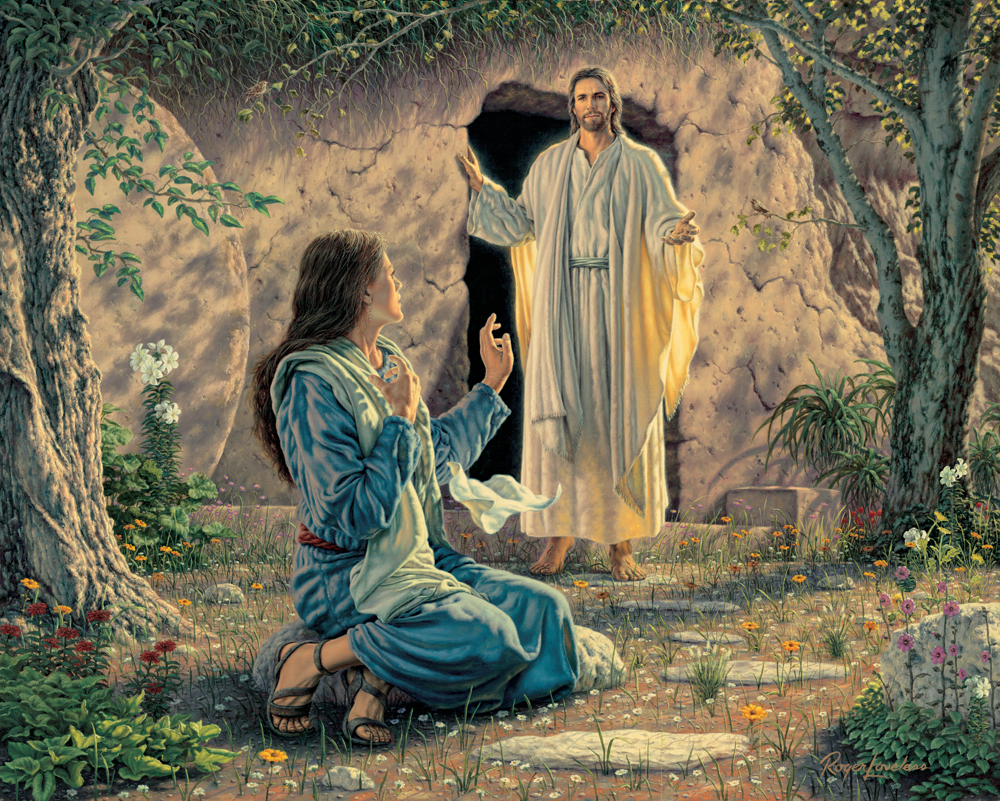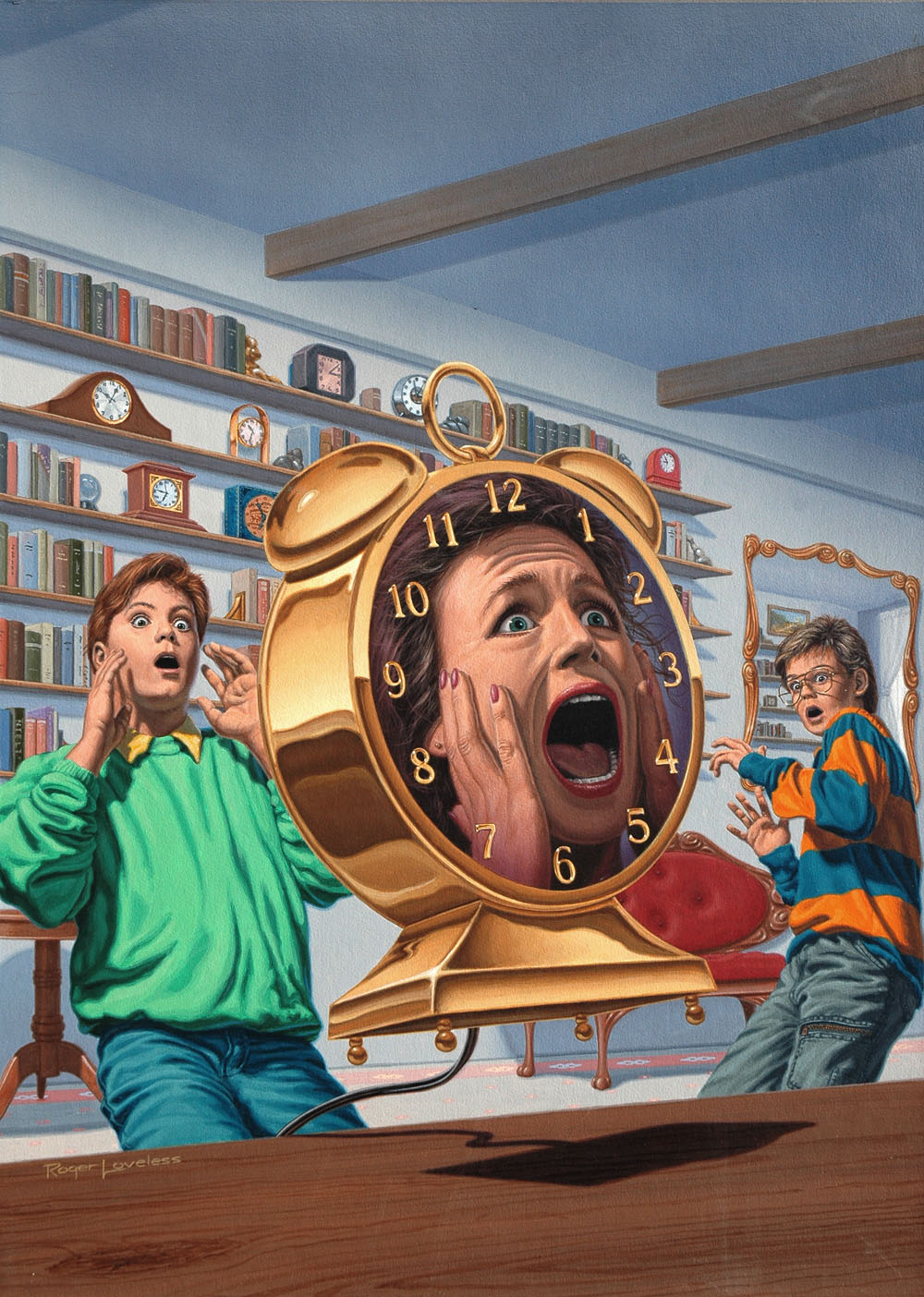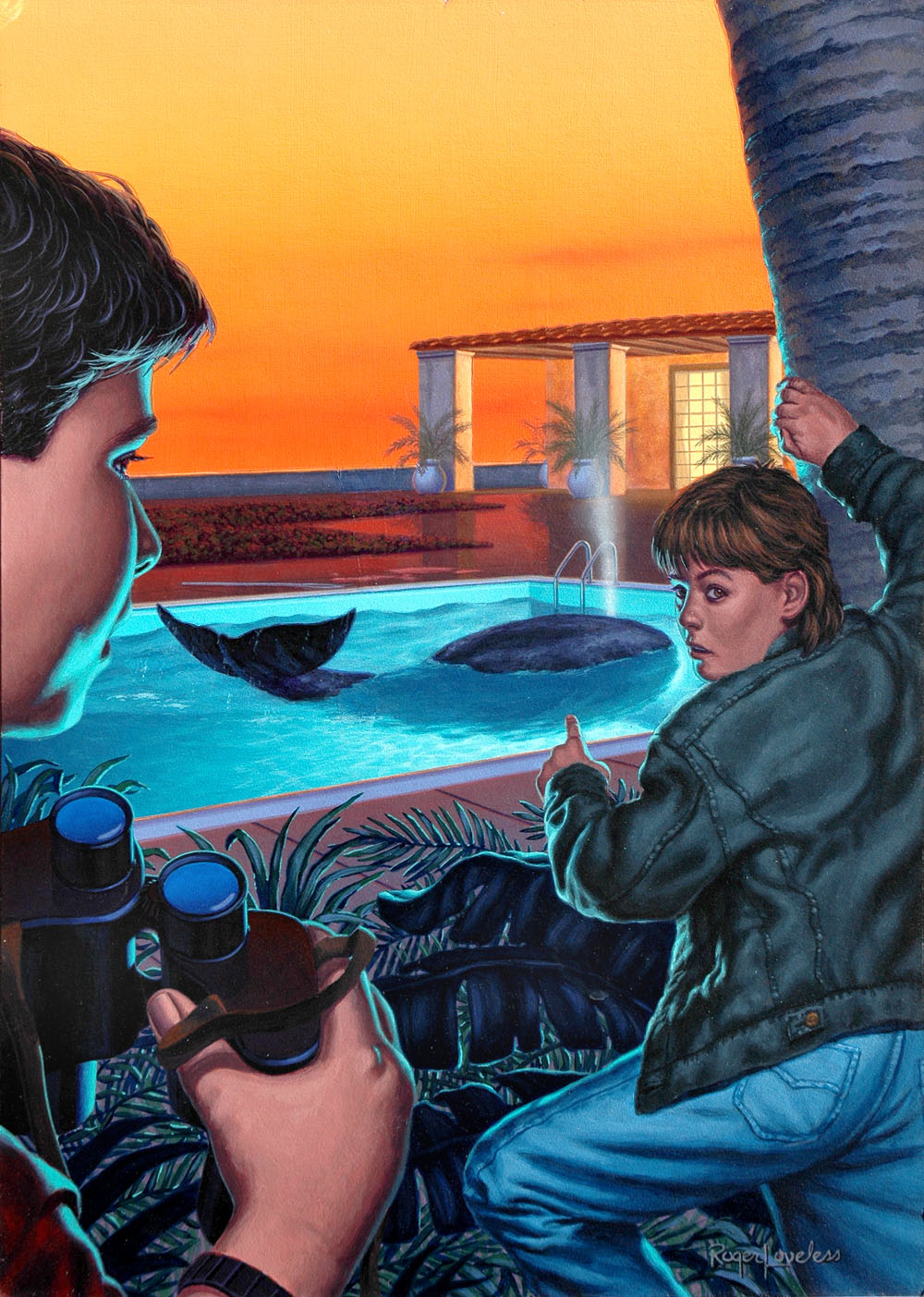 | ||||||
Three Investigators Artist
Roger K. Loveless
Roger Loveless in his studio on March 5, 2010 surrounded by the seven T3I covers he painted. Photo courtesy of Roger Loveless.
Roger Karl Loveless is one of two artists who created new cover art for the twelve titles published by the Alfred A. Knopf, Inc., Bullseye Books division in 1991 and 1992. Roger painted seven of the twelve: Terror Castle, Stuttering Parrot, Screaming Clock, Talking Skull, Blazing Cliffs, Kidnapped Whale and Missing Mermaid. Admired for their bright, attractive covers and high-quality paper stock, the Bullseye Books edition makes a handsome addition to any collection of Three Investigators books.
The following interview is based on e-mail correspondence between Roger and Seth that took place over the months of February and March 2010:
STS: Hi Roger, can you please share some background information with us?
RL: I was born in Utah in 1957 and graduated with a bachelor's degree in illustration from Utah State University in 1983. I worked on building my portfolio and did a lot of local illustration jobs, mostly book covers and games. Around 1986 I hooked up with an L.A. rep (Rosenthal Represents) and prepared to make the big move to Los Angeles. By then I was married with two kids, so it was a bit scary to up and leave with just a little savings in our pocket and move to a new location with no job waiting. We managed to survive somehow and stayed there for about four years before moving back to Utah. In 1990 I hooked up with Sal Barracca, who represented my work in New York, and started doing a lot of book covers. In fact, the covers for Terror Castle, Stuttering Parrot and Kidnapped Whale were the 2nd, 3rd and 4th illustration jobs done with Sal. Around 1999/2000, the industry started to change dramatically with computer illustrating and I started thinking of some new options. I took a job as an in-house illustrator for six years at Axiom Design where I picked up the infinite variety of techniques that are found on my website.
STS: Who are some of your artistic influences?
RL: I'm definitely influenced by some of the traditional old-time illustrators like N.C. Wyeth, Norman Rockwell and Arnold Friberg along with many modern contemporaries.
STS: Did you read or were you aware of The Three Investigators series as a boy?
RL: No, I never did read any from the series growing up although my older sister was an avid Nancy Drew fan, she had all the books. This series (T3I) reminded me of those covers. I was more into looking at the covers, as you can imagine a future illustrator would be!
STS: To the best of my knowledge you are the only T3I artist who wasn't based in or near New York City. Can you tell us how you got the assignment for T3I and the process involved in working with the publisher?
RL: That's interesting that only New York area artists worked on them. My agent at the time, Sal Barracca, worked out of New York. Usually, he would contact me to see if I was available to do the cover and then send me either the manuscript to read or just a synopsis of the book. I would then do some concept sketches and fax them to Sal. Sal was much more involved in the process than some reps were, which was usually helpful. I would provide them with a couple of choices, and, given the go, I would do a tighter sketch for the photographer to base the model shoot from.
Preliminary sketch #1.
Preliminary sketch #2.
Terror Castle original painting, 1990.
I designed Stuttering Parrot with all three boys but someone thought two would be better. The composition was better with all three. And I put the names of my best friends on the headstones - just for fun!
On Screaming Clock, the publishers wanted hour hands on the face but it would have looked like Alice in Wonderland and I didn't put them on. Turned out they really liked it without.
On the Kidnapped Whale cover I had originally painted the background with tall, skinny trees as a border just behind the small wall and the house was two-story. The publishers thought it interfered with the title and had me remove it all. Also, I had painted a girl on the edge of the pool holding a bucket of fish, feeding the whale. If you look closely, you can see a faint outline of her. This was pre-Photoshop days and I had to repaint the sky as well. As I recall, since they had approved the sketches, they had to pay me an additional fee. That is usually how it worked - if they approved a final sketch and later wanted something changed, they'd pay for it, whereas a color change was done as part of the original fee.
STS: Do you recall dealing with any difficulties in trying to execute a particular T3I cover? Do you have a favorite cover or two?
RL: I think my favorite is Screaming Clock followed by Missing Mermaid. When I did the Mermaid cover, I used my oldest daughter as the model, and she was VERY self-conscious about doing this without a shirt - even though she was only five at the time. As it turned out, after
they received the illustration, they decided the
mermaid needed to be a bit older - perhaps ten
years old and so I just winged it and made the
changes. My second oldest daughter just told
me that she was very jealous back then when
she didn't "get the modeling job"!
STS: How is an artist paid on work like this and approximately how long did it take to paint a T3I cover?
RL: I've sort of slacked off on keeping track of time to do a project these days, but I kept records of my work on T3I. Each of the seven covers were painted in acrylic paint and measure approximately (11"-14") x (14"-19"). Terror Castle, Stuttering Parrot and Kidnapped Whale were painted in 1990; Screaming Clock and Missing Mermaid were done in 1991 while Blazing Cliffs and Talking Skull were painted in 1992. Five of the paintings were commissioned at $2,300.00 each and the other two were $2,500 each.
There are several factors involving each painting that can affect the outcome and amount of time to complete the project. Many times, I would take on jobs when I was already working on an illustration - sometimes two. This was especially tough for me because my technique is pretty tight or photographic, and it takes a lot of time to do a painting. It wouldn't be uncommon to put in 16-to-20-hour days with an all-nighter to finish it off. Sometimes it would affect the finish with less detail, etc. There is also the time to complete drawings and get approval, line up and photograph models, allow shipping time and make changes, if any. Terror Castle, Stuttering Parrot and Blazing Cliffs each took about 41.5 hours to do. Kidnapped Whale and Talking Skull took 48 hours each while Missing Mermaid took 62 hours and Screaming Clock took 83 hours.
STS: According to one on-line biography, you grew up in a musical family that was very supportive of your early art efforts and that listening to music has a profound impact on the visual images in your mind. What types of music do you listen to when you work and do you recall what you may have been listening to when you painted your Three Investigators covers?
RL: Both of my parents were professional musicians and taught me to not only love classical music, but all kinds of music. When listening to classical music, I visualize some kind of story with accompanying imagery - depending on where I let it take my thoughts. While illustrating I tend to let the kind of music follow my mood at the time, rather than trying to force a frame of mind. So, when doing The Three Investigators series, I was listening to a lot of Led Zeppelin. Just kidding! Although I probably did some, it never really followed a specific pattern.
STS: The detail, depth and richness in an original painting never ceases to amaze me. The reproduction process never quite does a painting justice, what one sees on a book is usually adequate and nice but rarely compares to the original painting. For example, the wrinkles on the boys' jackets in the Blazing Cliffs cover
look fine but, in the actual painting itself, the illusion created with a few brush strokes is so realistic and life-like, it's just incredible. You have a real gift!
RL: Thank you.
The Mystery of the Missing Mermaid.
Original painting, 1991.
STS: Dominic Finelle was the artist who painted the other five covers in the Bullseye edition. Did you know him or any of the other artists who worked on T3I (Adragna, Marchesi, Vebell or Liese, to name a few)?
RL: No. I don't think Dominic Finelle was represented by Sal Barracca, but I'm not positive. A couple of the other names sound familiar but I'm not sure that I know their work.
STS: Browsing your website, I marvel at some of the fantastic, eye-catching illustrations you've produced over the years. For example, there's an amazing painting showing a human skull bursting through a bookshelf, what was that one for?
RL: That's the cover for a book called Real-Life Scary Places. I have a few illustrations that fit into my "favorites" category that I won't part with, and this is one of them. It was a really fun one to do. In fact, I bought and built the skull model when I started free-lancing in L.A. and ended up using it for reference four times (so far!) including the Talking Skull cover.
STS: Religious and spiritual themes appear to play a large role in your artistic output in recent years.
RL: About ten years ago, when the industry started changing, I did a religious commission painting and found a new kind of satisfaction. I've always been a religious person and attributed my abilities to God, so this seemed like a way to give something back. I decided to pursue the print market and to make inspirational art the subject. My good friend, Greg Olsen, was already doing this and was doing quite well, so I thought it might work. I continued illustrating (and still am!) the same variety of other subjects at the same time.
STS: It's been a real joy to see your paintings and to hear about your experience with T3I, thank you! What does the future hold for Roger Loveless?
RL: It was fun in pulling the paintings out because I was able to photograph about a hundred and fifty other illustrations that I hadn't seen in a while - including some college and high school work! I plan on continuing with whatever illustrations come along and doing more "inspirational" work, branching out doing my own prints and marketing them.
The models and photographer were from New York and I had no input during the shoot. It would have been nice to help direct the models a bit - they were sometimes pretty stiff, and I would have to go with what I got. Also, they switched models a couple of times but tried to maintain the general character profile. Unfortunately, I can't find any of the modeling photos that I worked from, but I do have most of my preliminary sketches. They range from very, very rough idea and compositional thumbnails to finished sketches. I wasn't too worried about much detail or realism - it was just to get the idea across.
It was always a bit of a challenge to read an entire manuscript and narrow down the cover to a single scene or concept. But usually, it was a natural fit and I didn't have to be too literal. And, since it's the "cover that sells" the book (in a lot of cases), an illustrator wants to create some intrigue or curiosity for the viewer that will make them want to read the book . . . and, of course, buy it.
STS: Did you ever view previous Three Investigators covers to give you some ideas to work with or did your paintings evolve directly from the manuscripts that you read?
RL: I was shown a past example of the cover art for the first book I did, Terror Castle, but it was not to be copied. That is the only one I remember seeing.
Click HERE to view larger, more detailed photographs of the
seven T3I paintings created by Roger Loveless.
Click HERE to view the preliminary sketches for the covers.
Our favorite villain, Huganay, almost made it to the cover of
The Mystery of the Stuttering Parrot!
To see more of Roger's work, much of which is for sale,
please visit his website at: http://www.rogerlovelessart.com
(The T3I artwork is not available for sale.)
Back to the Authors/Artists page.
All images on this page courtesy of Roger Loveless,
Inspirational Art.
My Redeemer Lives. Roger Loveless, Inspirational Art.
 | ||||||
 | ||||||
